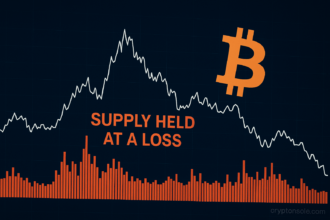The crypto market, known for its high volatility, has seen a sharp decline today, with the prices moving negatively and making the traders and investors one common question: Why is crypto down today? After a significant rally that led Bitcoin over $120,000 and brought Ethereum close to the $3,200 level, the prices have gone in the opposite direction.
In the space of less than a day, the global crypto market cap obliterated billions of dollars, sending tremors through Bitcoin, altcoins, and meme coins. It is not a new phenomenon for digital assets to go through corrections, but if we know the reasons behind the current downfall, investors can plan better. This article discusses the main reasons for the crash and the consequence of the future of crypto.
1. Profit‑Taking After New All‑Time Highs
Bitcoin and Ethereum have just surged to new records—Bitcoin went beyond $120,000—thus many investors decided to withdraw their profits. A domino effect of selling across the market ensued. Hence, the overall crypto market cap fell by almost 7% in a single day. Furthermore, the increase in crypto trading volume brought along with it price volatility, whereas the elimination of leveraged long positions added to the negative trend.
2. ETF Outflows Impact Investor Sentiment
On the other hand, minor outflows from some funds have slightly dented5 short-term investor confidence though long-term interest in spot Bitcoin and Ethereum ETFs from institutional investors remains strong. The withdrawal of capital by institutional investors even temporarily, however, creates nervousness in the broader market. This caused a broad sell-off among the top altcoins such as Solana, Dogecoin, and XRP.
3. Macro‑Economic Headwinds: Rates & Inflation
Macroeconomic data continues to impact investors’ behavior. A recent drop in inflation in the United States initially buoyed the sentiment but the upbeat mood was short-lived. Those who put their money into the stock market were quick to turn cautious based on the Federal Reserve’s response to this in future conferences. Increased interest rates usually mean that assets like crypto go down as they use less liquidity and there is a higher opportunity cost.
4. Geopolitical & Regulatory Uncertainty
Energy and climate change also affect crypto prices. However, this is probably the least significant factor compared to global regulations and ongoing geopolitical tensions. The difficulty to get pro-crypto laws passed along with the recent troubles has resulted in the further shrinking of institutional crypto investors pool. The ambiguity of regulations is still there and consequently, investors’ sentiments are quite volatile and more cautious trading, especially altcoins, is now observed.
5. Security Breaches Shake Confidence
The crypto ecosystem still endeavours to overcome security issues. An incident of $44 million theft from a local Indian exchange has ignited again the arguments about platform safety. Although the majority of exchanges have improved their cybersecurity, incidents such as this one give users a reminder of the continuous vulnerabilities in the crypto infrastructure. This situation weakens market confidence and could trigger short-term sell pressure.
Market Snapshot
- The total cryptocurrency market capitalization has lost approximately 6.7% of its value and is now moving between $3.7 and $3.8 trillion.
- Bitcoin is trading at a level of less than $117,000, representing a 4.4% decline in 24 hours.
- Ethereum has followed a similar pattern and has fallen below the $3,000 mark.
- Altcoins have experienced heavier losses, with more than 90 of the top 100 tokens in the red.
- Overall, the trading volume reached $200 billion for the 24 hours to now, which suggests that there has
Long‑Term Outlook: Signs of Resilience
Institutional Confidence Still Intact
Even during downturns, the inflows into Bitcoin and Ethereum ETFs indicate continued interest from big financial players. Institutions view these dips as potential buying opportunities, not exits.
Market Corrections Are Normal
Analysts point out that corrections of 5–10% are healthy, especially during bull markets. Such dips help reset overly bullish sentiment and allow for a more sustainable rally moving forward.
What Should Investors Do Now?
- Stay calm and avoid panic selling. Market corrections are part of the investment cycle.
- Track macro indicators. Pay attention to U.S. economic data, interest rate policies, and global political developments.
- Diversify your crypto portfolio. A balanced mix of Bitcoin, Ethereum, and carefully selected altcoins can help reduce risk.
- Improve asset security. Always use secure wallets, enable two-factor authentication, and stay updated on exchange safety protocols.
Conclusion
The current dip in crypto prices is the result of a combination of factors: profit-taking after a strong rally, ETF outflows, inflation-related caution, regulatory roadblocks, and security issues. While these factors have spooked investors in the short term, the long-term outlook for crypto remains bullish. Institutional inflows, increasing mainstream adoption, and maturing regulation are likely to support recovery. For patient investors, today’s volatility could be tomorrow’s opportunity.
Also Read: Best Crypto Presale: Top Picks for 2025












